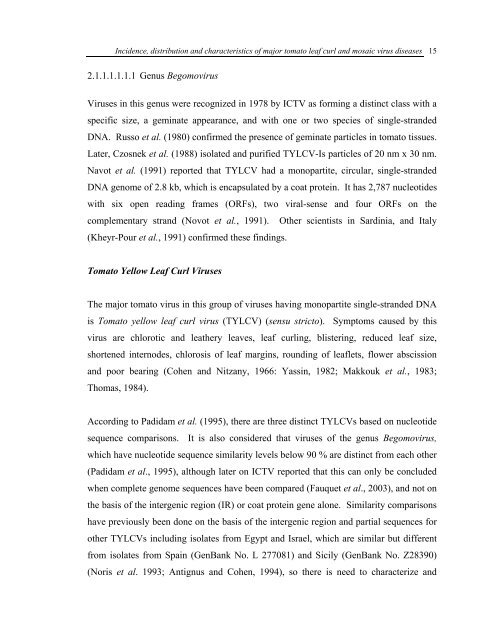Incidence, Distribution and Characteristics of Major Tomato Leaf ...
Incidence, Distribution and Characteristics of Major Tomato Leaf ...
Incidence, Distribution and Characteristics of Major Tomato Leaf ...
Create successful ePaper yourself
Turn your PDF publications into a flip-book with our unique Google optimized e-Paper software.
<strong>Incidence</strong>, distribution <strong>and</strong> characteristics <strong>of</strong> major tomato leaf curl <strong>and</strong> mosaic virus diseases<br />
2.1.1.1.1.1.1 Genus Begomovirus<br />
Viruses in this genus were recognized in 1978 by ICTV as forming a distinct class with a<br />
specific size, a geminate appearance, <strong>and</strong> with one or two species <strong>of</strong> single-str<strong>and</strong>ed<br />
DNA. Russo et al. (1980) confirmed the presence <strong>of</strong> geminate particles in tomato tissues.<br />
Later, Czosnek et al. (1988) isolated <strong>and</strong> purified TYLCV-Is particles <strong>of</strong> 20 nm x 30 nm.<br />
Navot et al. (1991) reported that TYLCV had a monopartite, circular, single-str<strong>and</strong>ed<br />
DNA genome <strong>of</strong> 2.8 kb, which is encapsulated by a coat protein. It has 2,787 nucleotides<br />
with six open reading frames (ORFs), two viral-sense <strong>and</strong> four ORFs on the<br />
complementary str<strong>and</strong> (Novot et al., 1991). Other scientists in Sardinia, <strong>and</strong> Italy<br />
(Kheyr-Pour et al., 1991) confirmed these findings.<br />
<strong>Tomato</strong> Yellow <strong>Leaf</strong> Curl Viruses<br />
The major tomato virus in this group <strong>of</strong> viruses having monopartite single-str<strong>and</strong>ed DNA<br />
is <strong>Tomato</strong> yellow leaf curl virus (TYLCV) (sensu stricto). Symptoms caused by this<br />
virus are chlorotic <strong>and</strong> leathery leaves, leaf curling, blistering, reduced leaf size,<br />
shortened internodes, chlorosis <strong>of</strong> leaf margins, rounding <strong>of</strong> leaflets, flower abscission<br />
<strong>and</strong> poor bearing (Cohen <strong>and</strong> Nitzany, 1966: Yassin, 1982; Makkouk et al., 1983;<br />
Thomas, 1984).<br />
According to Padidam et al. (1995), there are three distinct TYLCVs based on nucleotide<br />
sequence comparisons. It is also considered that viruses <strong>of</strong> the genus Begomovirus,<br />
which have nucleotide sequence similarity levels below 90 % are distinct from each other<br />
(Padidam et al., 1995), although later on ICTV reported that this can only be concluded<br />
when complete genome sequences have been compared (Fauquet et al., 2003), <strong>and</strong> not on<br />
the basis <strong>of</strong> the intergenic region (IR) or coat protein gene alone. Similarity comparisons<br />
have previously been done on the basis <strong>of</strong> the intergenic region <strong>and</strong> partial sequences for<br />
other TYLCVs including isolates from Egypt <strong>and</strong> Israel, which are similar but different<br />
from isolates from Spain (GenBank No. L 277081) <strong>and</strong> Sicily (GenBank No. Z28390)<br />
(Noris et al. 1993; Antignus <strong>and</strong> Cohen, 1994), so there is need to characterize <strong>and</strong><br />
15





